
Seventy-five years after Independence and 20 years after the NWMI was launched, women journalists in India are still in a minority, and the Indian media has no SC or ST journalists in leadership roles. What makes for this poor representation and what are the factors that hinder women journalists—especially those from oppressed castes—from being recruited, promoted and occupying leadership positions in the Indian media? Alongside, poor wages, lack of job security and workplace harassment seriously threaten the professional base of journalism. Online abuse has serious ramifications on the mental health of women journalists, their work and for media freedom. This session explored online harassment of women journalists, cyber security and mitigation strategies as well as the barriers to gender justice, caste discrimination and exclusion in newsrooms and media workplaces. It came up with practical steps to make newsrooms genuinely inclusive and diverse.
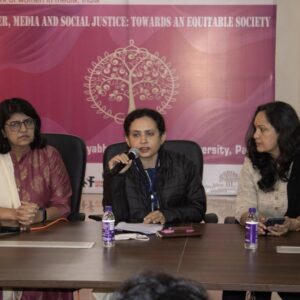 Ramya Kannan, the moderator, introduced the session by highlighting that NWMI gives space to regional media and regional language media, as also journalists from marginalized sections. She spoke of the online abuse many women journalists faced, across the world. Women journalists such as Gauri Lankesh had were killed for expressing their opinions. Organisational structures enable marginalization, she said, citing caste in the newsroom, and the difficulties journalists faced in Kashmir since the abrogation of Article 370.
Ramya Kannan, the moderator, introduced the session by highlighting that NWMI gives space to regional media and regional language media, as also journalists from marginalized sections. She spoke of the online abuse many women journalists faced, across the world. Women journalists such as Gauri Lankesh had were killed for expressing their opinions. Organisational structures enable marginalization, she said, citing caste in the newsroom, and the difficulties journalists faced in Kashmir since the abrogation of Article 370.
Anuradha Sharma, independent journalist from Siliguri, began by saying, “I’m an independent girl reporter” (a humorous reference to the term used by a panellist at the public meeting the previous day). She spoke about toxic masculinity in the newsroom, and the stereotyping of women as being ‘fit’ for certain roles and beats. “Come out of your comfort zone, men say to us. This is what it is to be a girl journalist, not wanting to come out of your comfort zone. This is often the reputation of women in newsrooms. The very nature of understanding the job of a journalist in non-urban spaces is that it is a man’s job,” she said. She explained that toxic masculinity also affected the way women displayed their authority. “If you’re doing a man’s job, you should be like a man. Women become bottled in because they have to fit into this structure. We have to address this toxic masculinity in newsrooms,” she said.
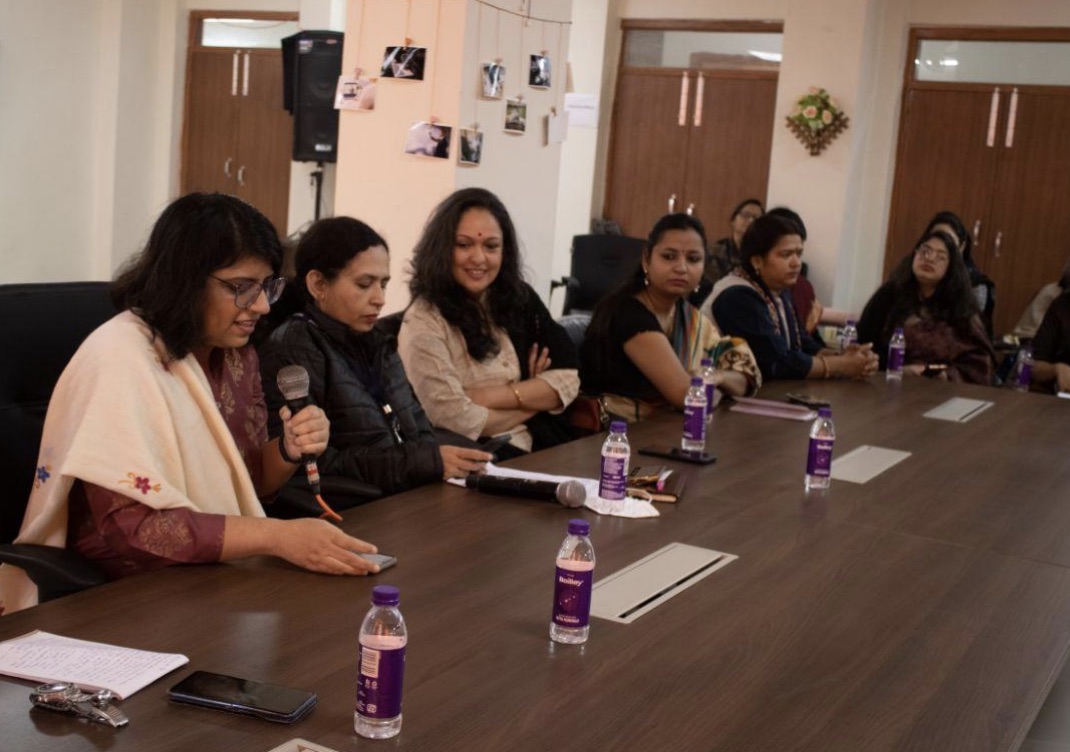
Priti Salian, independent journalist from Bengaluru spoke about “A 9-step plan for ‘curb-cutting’ disability access in India’s news and newsrooms”, which she had created for the Reuters Institute for the Study of Journalism. “There is little awareness what a disability could mean for journalists. The barrier is not just ramp or wheelchair access. Barriers could be parents telling disabled youngsters not to work in a risky profession, not finding access, not finding the right place to work. Not having the right networks.”
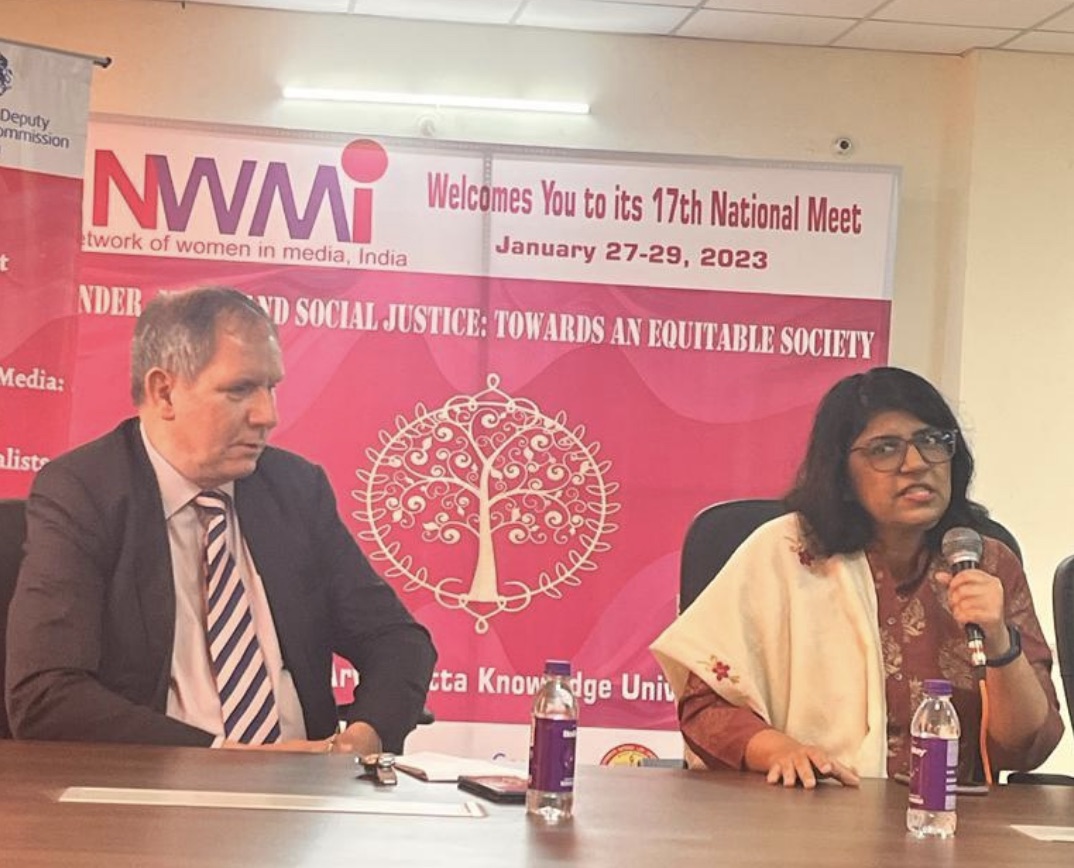
She recounted an instance when a journalist was unable to go into a national newsroom due to lack of wheelchair access. There was no action from the administration for four months. Another was kept waiting for one year because they couldn’t construct a ramp or accessible toilet for him. One blind journalist said, what can you do for us? One editor asked a blind journalist, ‘Will you be able to commute and report from ground?’ The journalist replied: ‘I will do it just like anyone else, I’ll take an auto and go there.’ Journalists have to ask questions to understand disabled journalists. A large part of the problem of inclusivity is not having conversations about disability, and not having an environment where they can open up and talk about their disability, she explained.
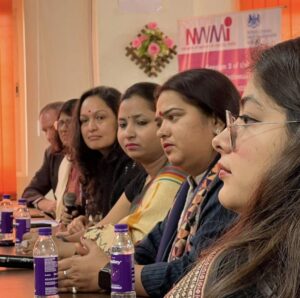 Kumari Vaishnavi from the Viklang Adhikar Manch, Bihar, said, “Gender, caste, and disability all work against us.” Making a case for solidarity, she explained that even a few women being oppressed or held back due to disability was akin to all women being oppressed. “We have only two options: Either we struggle or just go home, after which the only option is to sleep and die. We have to walk together if we decide we will not let oppressive forces work,’ she said, elaborating that there was no difference between ‘women’ and ‘women with disabilities’. On terminology, whether divyang or disabled, or differently abled, Kumari said, “Whatever term you use, just bring the issues to the fore whether you use the politically correct terminology or not.”
Kumari Vaishnavi from the Viklang Adhikar Manch, Bihar, said, “Gender, caste, and disability all work against us.” Making a case for solidarity, she explained that even a few women being oppressed or held back due to disability was akin to all women being oppressed. “We have only two options: Either we struggle or just go home, after which the only option is to sleep and die. We have to walk together if we decide we will not let oppressive forces work,’ she said, elaborating that there was no difference between ‘women’ and ‘women with disabilities’. On terminology, whether divyang or disabled, or differently abled, Kumari said, “Whatever term you use, just bring the issues to the fore whether you use the politically correct terminology or not.”
Srishti Jaswal, independent journalist and digital security trainer who has faced serious online trolling, said, “I was trolled online, and the abuse goes on in stages even though I am an upper-caste Hindu woman, and it would be much worse for a Muslim or lower caste woman. My family was impacted by violence, which was extreme. The experience brought about a lot of consciousness and empathy. ‘Why me?’ Asking this led me to many solutions that I wish share with you today.
“When you’re going through online abuse, save everything. Document everything, whether you want to take the legal route or not. When this happened to me, I didn’t understand how it began. When I began to look into it, I realized there is an IT cell that was spreading misinformation. They used WhatsApp, Telegram etc. to send these messages to a wide network.”
Highlighting the importance of protecting oneself while doing the work of a journalist, she said, “You are free till words come out of your mouth. You have freedom till you speak. Write it and say it in a way that can be protected legally.”
Srishti shared the following tips to tackle online abuse: “Take care of your mental health, social media is very draining. We live in semi-celebrity culture, and many people know us, but it is draining. Our work culture is such that we are forced into public life, doesn’t matter how many followers you have. It is important to be careful. If something like this happens, you should have someone to reach out to. Solidarity is important. At the time, I didn’t know NWMI. Thousands of people were hurling abuse at me, and raising questions on my character, using photos. I was wondering: is this is me? People told me, it’s not you, and having support like that is very important. A monthly circle of sexual harassment really helps. When I was being trolled, it continued for a week. Many are trolled because they are women or from marginalized communities, even ordinary people are being trolled.
Srishti concluded by exhorting women journalists to read the laws, and keep codes of journalism in mind while reporting.
Talking about journalism in Kashmir, a journalist from the Union Territory said that after the abrupt abrogation of Article 370 on 4 August 2019, there was a shift in political and geographical realities. The first targets were journalists. “We woke up to a communication blackout: no phones or internet. The intention was that news should not go out of the region.” Despite the restrictions, journalists who have lived through such hardships for decades went about their jobs. Someone went to the airport and sent out news via pen drive, others used OB vans to read out news to friends or colleagues – that’s how the first couple of months unfurled. Later, there was frequent summoning and questioning. Before, mostly male journalists faced that kind of intimidation and violence, but now women are not spared. There was no soft approach. The worst part is the continuing restrictions. Journalists require permission from the court to travel, the journalist said, giving the example of Sana Mattoo who was on the team that won the Pulitzer Prize, but was not allowed to attend the award ceremony. “Much of this harassment is invisible, and 90 per cent of the journalists at home do not speak about it. People feel like they are safe only if they are silent. They think if you speak, your family won’t be spared. We don’t see a way out. I might get solidarity if I speak. Immediately, if I put out a tweet, there will be statements and other solidarity. But by the third day, when I am in the lion’s den, who will support me?”
Speaking about self-censorship, the journalist said one had to be very careful with language and vocabulary as one could never know what word or phrase would be targeted and become the cause for a backlash. “There is news, and things are happening but we cannot report. Journalists have been the window to Kashmir, and with that window shut, everyone thinks that everything is fine.” There is silence. People are self-censoring. whoever is able to save themselves and their families do so – it is their top priority. Some fellow journalists say they cannot sleep without medicines. There are mental scars that are not healing. I don’t want to be quoted anywhere or put on social media. I feel this is a safe space to say what I can.

As Ramya summed up, “It is clear from what we have heard that there is an immense cost to doing journalism today.”
Ismat Ara, a reporter with the Frontline magazine, narrated her experience of being harassed and intimidated while reporting on the field and said, “I’m still struggling to figure out how to be a Muslim woman journalist.” Last year, her photograph was put on a poster and shared widely as the ‘bulli bai deal of the day’. “It is tricky today to be a Muslim woman journalist,” she said. “We negotiate a lot to come out of our homes. When things like these happen, I don’t know what to say to my family.” She has filed FIRs but the accused get out on bail, leading to further fears about harassment. “Now I’ve started self-censoring myself… What do I write that may be (construed as) politically incorrect? I am still struggling to deal with the fact that I am a Muslim woman writing on issues,” she said.
Srishti added, “When you target women or a few people, it leads to creating a general atmosphere of self-censorship. They want to silence everyone through one person. It is a thought-out agenda.”
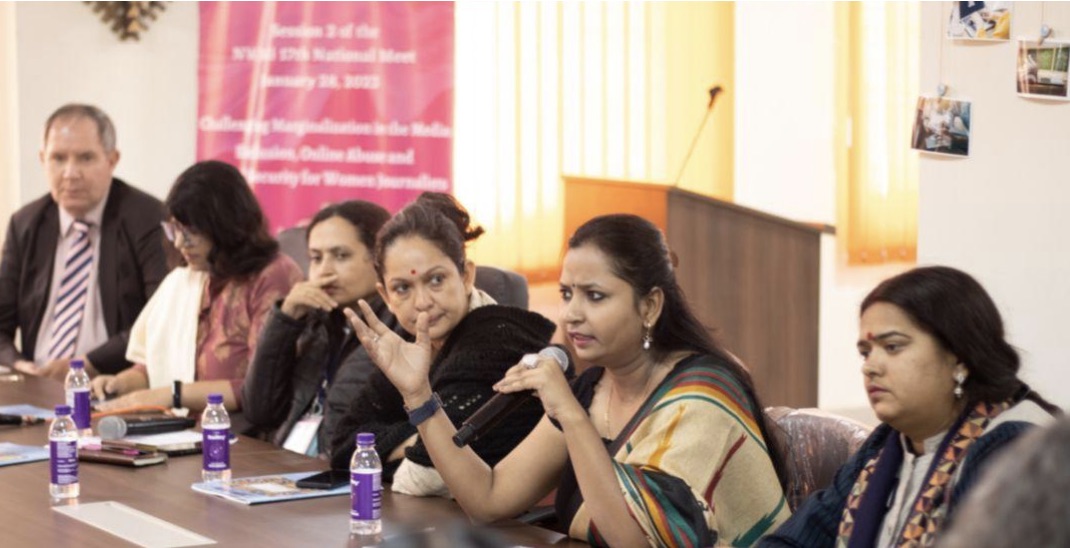
Meena Kotwal, editor of Mooknayak, talked about caste in the newsroom. “We need to change some things in the newsroom because there is only one section of people in the newsroom who have never faced this type of caste discrimination,” she said. Greater diversity of in the newsroom—with Dalit, ST and OBC reporters—is the only way to ensure that issues affecting different communities get equal play. A journalist from OBC community once told their editor that there has been an episode against Dalit, but the editor asked, ‘what is new about this? This keeps happening.’ They think Dalit issues ‘keep happening’, so why should we cover them? You can imagine how they bring Dalit issues on board. We need to include people who recognize these issues.
“Someone told me, (Dalit) people are coming into newsrooms only recently, so how can they be in decision making? They acknowledge that there are no Dalits in the newsroom. This is your shortfall, not ours,” she said. The onus of bringing about change in newsrooms in put on Dalits. “As journalists, we have no caste or religion, but the latter are always placed before our identities as journalists to enable change in newsrooms,” she said, telling an anecdote about a former editor who had told her they do not consider caste while hiring. “You shouldn’t but you must be considering something if the same kind of people are entering newsrooms. What kind of filter allows you to keep them [in and us out]?… The more we are silent, we will be oppressed. We must be springs—the more you push us down, the more we jump back.”
“You will notice that in Dalit issues, there is a lot of focus on the culprit. Names (last name) never revealed with upper castes, but when the accused is Dalit, their last names and caste are revealed. In the Hyderabad gang-rape case, there was an immediate police encounter of the Dalit accused. When there is an upper caste culprit, the cases go on for years. The Kashmir temple rape case, for example,” she pointed out.
Nick Low, British Deputy High Commissioner, East and Northeast India, said, “As regards women in journalism in my country, the UK, we have a lot of diversity as we are a multi-racial society. The media should reflect that. We cannot discriminate. One particularly important factor is the different social classes in my country In the 1970s, news casters Angela Rippon and Anna Ford had three things in common, they were white, young and good looking. That was a barrier. Eventually we saw women of colour appearing on TV, some slightly older. Whatever your ethnicity, whatever your appearance, if you’re good enough, you can break in. The visible differences – sexuality, disability, social class, much more difficult to get hold of. British journalists are drawn from 7% of people who have private school education. It is not diverse. Private education is very expensive, there are scholarships but they are an exception. This is what journalism in my country looks like.”
Moving on to other current issues like the online safety bill, Low talked about the rich debates in the British parliament and the media. “The online safety bill will regulate companies that use generated content, terrorism and violence. Child pornography, abuse and exploitation is the other issue. That is unlawful and will not be allowed.” The bill would also consider ‘legal but harmful’ content such as smoking and drinking, which are legal but harmful. This section will also be used to tackle sites that distribute material which advocates or endorses behaviours that could be harmful in the long run, such as anorexia, bulimia and eating disorders.
Low illustrated this with the tragic story of 14-year-old Molly Russel, who took her life in 2017. When the family’s computer was checked, it was found that for a year and a half she had been visiting sites encouraging bad eating habits and ultimately offering suicide as an option. “I think the online safety bill will be known as Molly’s Law and will encourage rigorous monitoring and taking down material reported to be problematic,” he said.


